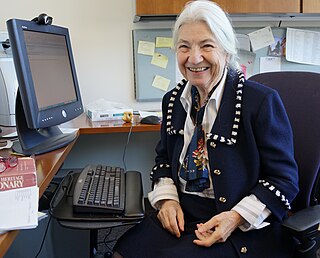The Association for Computing Machinery (ACM) is a US-based international learned society for computing. It was founded in 1947 and is the world's largest scientific and educational computing society. The ACM is a non-profit professional membership group, reporting nearly 110,000 student and professional members as of 2022. Its headquarters are in New York City.

SIGGRAPH is an annual conference centered around computer graphics organized by ACM, starting in 1974. The main conference is held in North America; SIGGRAPH Asia, a second conference held annually, has been held since 2008 in countries throughout Asia.
Joseph Frank Ossanna, Jr. was an American electrical engineer and computer programmer who worked as a member of the technical staff at the Bell Telephone Laboratories in Murray Hill, New Jersey. He became actively engaged in the software design of Multics, a general-purpose operating system used at Bell.

David Harold Bailey is a mathematician and computer scientist. He received his B.S. in mathematics from Brigham Young University in 1972 and his Ph.D. in mathematics from Stanford University in 1976. He worked for 14 years as a computer scientist at NASA Ames Research Center, and then from 1998 to 2013 as a Senior Scientist at the Lawrence Berkeley National Laboratory. He is now retired from the Berkeley Lab.

PL/C is an instructional dialect of the programming language PL/I, developed at the Department of Computer Science of Cornell University in the early 1970s in an effort headed by Professor Richard W. Conway and graduate student Thomas R. Wilcox. PL/C was developed with the specific goal of being used for teaching programming. The PL/C compiler, which implemented almost all of the large PL/I language, had the unusual capability of never failing to compile a program, through the use of extensive automatic correction of many syntax errors and by converting any remaining syntax errors to output statements. This was important because, at the time, students submitted their programs on IBM punch cards and might not get their output back for several hours. Over 250 other universities adopted PL/C; as one late-1970s textbook on PL/I noted, "PL/C ... the compiler for PL/I developed at Cornell University ... is widely used in teaching programming." Similarly, a mid-late-1970s survey of programming languages said that "PL/C is a widely used dialect of PL/I."
Edmund Callis Berkeley was an American computer scientist who co-founded the Association for Computing Machinery (ACM) in 1947. His 1949 book Giant Brains, or Machines That Think popularized cognitive images of early computers. He was also a social activist who worked to achieve conditions that might minimize the threat of nuclear war.

The Design Automation Conference, or DAC, is an annual event, a combination of a technical conference and a trade show, both specializing in electronic design automation (EDA).
SIGDA, Association for Computing Machinery's Special Interest Group on Design Automation, is a professional development organization for the Electronic Design Automation (EDA) community. SIGDA is organized and operated exclusively for educational, scientific, and technical purposes in electronic design automation. SIGDA's bylaws were approved in 1969, following the charter of SIC in Design Automation in 1965.
Thomas Albert "Tom" DeFanti is an American computer graphics researcher and pioneer. His work has ranged from early computer animation, to scientific visualization, virtual reality, and grid computing. He is a distinguished professor of Computer Science at the University of Illinois at Chicago, and a research scientist at the California Institute for Telecommunications and Information Technology (Calit2).

Rodnay Zaks is a French-born American author of many books on computer programming, including the seminal Programming the Z80 and Programming the 6502. He is the founder of independent computer book publisher Sybex and was its president and chief executive officer (CEO) until its takeover by John Wiley & Sons in May 2005.

Ruzena Bajcsy is an American engineer and computer scientist who specializes in robotics. She is professor of electrical engineering and computer sciences at the University of California, Berkeley, where she is also director emerita of CITRIS.
Donn B. Parker was an information security researcher and consultant and a 2001 Fellow of the Association for Computing Machinery. Parker had over 50 years of experience in the computer field in computer programming, computer systems management, consulting, teaching, and research.
Bruce Gilchrist is considered one of the notable figures in modern computing history.
The American Federation of Information Processing Societies (AFIPS) was an umbrella organization of professional societies established on May 10, 1961, and dissolved in 1990. Its mission was to advance knowledge in the field of information science, and to represent its member societies in international forums.

Byte was a microcomputer magazine, influential in the late 1970s and throughout the 1980s because of its wide-ranging editorial coverage.
The Joint Computer Conferences were a series of computer conferences in the United States held under various names between 1951 and 1987. The conferences were the venue for presentations and papers representing "cumulative work in the [computer] field."
Venkata Narayana Padmanabhan is a computer scientist and principal researcher at Microsoft Research India. He is known for his research in networked and mobile systems. He is an elected fellow of the Indian National Academy of Engineering, Institute of Electrical and Electronics Engineers and the Association for Computing Machinery. The Council of Scientific and Industrial Research, the apex agency of the Government of India for scientific research, awarded him the Shanti Swarup Bhatnagar Prize for Science and Technology, one of the highest Indian science awards for his contributions to Engineering Sciences in 2016.
The PB 250 was a general-purpose computer introduced in 1960 by the Packard Bell Corporation.






